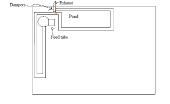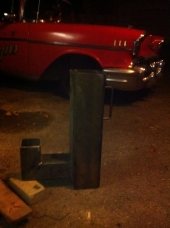


 Why not consider putting copper coils around the rocket riser, then run "PEX" piping underground to the pond into another copper coil which would be your heat exchanger for the pond water. At this scale, I would imagine that 3/4" tubing would be the minimum size required. If idle-use freezing is an issue, your could use just enough propylene glycol (RV antifreeze) to fill the tubing, and a small, atmospheric feed reservoir. You would also need a small circulator pump for the system. It is possible to eliminate the need for a pump, by upsizing the tubing on the return side of the system, thereby achieving "gravity" flow. The pump would be much more efficient, though, in terms of speed of heat transfer. :
Why not consider putting copper coils around the rocket riser, then run "PEX" piping underground to the pond into another copper coil which would be your heat exchanger for the pond water. At this scale, I would imagine that 3/4" tubing would be the minimum size required. If idle-use freezing is an issue, your could use just enough propylene glycol (RV antifreeze) to fill the tubing, and a small, atmospheric feed reservoir. You would also need a small circulator pump for the system. It is possible to eliminate the need for a pump, by upsizing the tubing on the return side of the system, thereby achieving "gravity" flow. The pump would be much more efficient, though, in terms of speed of heat transfer. :



 Thanks, John. If I can have your email address, I'll send you some I-phone pics. I am roy_emerson@hotmail.com. I am new to Permies, and I don't draw well. Sooner or later, I'll get out the mechanical drawing tools, and get this down in black and white.
Thanks, John. If I can have your email address, I'll send you some I-phone pics. I am roy_emerson@hotmail.com. I am new to Permies, and I don't draw well. Sooner or later, I'll get out the mechanical drawing tools, and get this down in black and white.
 I have built a "combo" RMH unit that will produce steam and hot water that runs 2 separate coils, 1 around the 4" (insulated)riser, and another looped through the secondary chamber. It works quite well, except it can be a little ticklish to get "kindled up". My stack temperature has yet to exceed 80 degrees F. I have overcome the initial draft problem by the addition of a draft inducer blower, installed in such a way that it can be shut down once the secondary temp is sufficient for sustained drafting. Basically, this works just like a modern 90+% efficiency gas furnace, except it is not necessary to leave the blower in operation during firing. The coils are valved in such a way that I can use them separately or in tandem for water & steam, steam, or just water.
I have built a "combo" RMH unit that will produce steam and hot water that runs 2 separate coils, 1 around the 4" (insulated)riser, and another looped through the secondary chamber. It works quite well, except it can be a little ticklish to get "kindled up". My stack temperature has yet to exceed 80 degrees F. I have overcome the initial draft problem by the addition of a draft inducer blower, installed in such a way that it can be shut down once the secondary temp is sufficient for sustained drafting. Basically, this works just like a modern 90+% efficiency gas furnace, except it is not necessary to leave the blower in operation during firing. The coils are valved in such a way that I can use them separately or in tandem for water & steam, steam, or just water.

Odds are extremely good that those who never make mistakes, never DO anything...engineering is 80% experimentation, 10% research,5% ability, and 5% effort.Roy Emerson wrote: :
Jeremiah, the extended heat capability of an RMH is obtained by using it in a mass heating mode, be it water or masonry. In addition to the cleanliness of burn and the expediency of available heat, the RMH is compact and lends itself readily to hydronic or convection apps. I am about 90% finished with a unit I built to produce both steam and hot water, either individually, separately, or simultaneously (2 coils). My fuel chamber measures 6" by 8" by 12", and I have gotten as much as a 3-hour productive burn out of it, depending on the fuel I use. It now will burn 5" X 10" firewood, wood pellets, or biomass briquettes. So far, I have been pleased and amazed at the results. I plan to extend the fuel chamber height to 16". The combustion air can enter either thru the bottom load, or through the fuel chamber lid, or both, as needed. With both coils in operation hydronically pumped by a small circulator, I have achieved a 120 degree rise in 5 g of water, in 20 minutes.
 :
: Well, y'all, mainly what I need is various gears and brngs for the tailstock. Lil fingers, dontcha know. Shifting my lathe like it was a Ferrari...few years back...
Well, y'all, mainly what I need is various gears and brngs for the tailstock. Lil fingers, dontcha know. Shifting my lathe like it was a Ferrari...few years back...

 Jeremiah, the extended heat capability of an RMH is obtained by using it in a mass heating mode, be it water or masonry. In addition to the cleanliness of burn and the expediency of available heat, the RMH is compact and lends itself readily to hydronic or convection apps. I am about 90% finished with a unit I built to produce both steam and hot water, either individually, separately, or simultaneously (2 coils). My fuel chamber measures 6" by 8" by 12", and I have gotten as much as a 3-hour productive burn out of it, depending on the fuel I use. It now will burn 5" X 10" firewood, wood pellets, or biomass briquettes. So far, I have been pleased and amazed at the results. I plan to extend the fuel chamber height to 16". The combustion air can enter either thru the bottom load, or through the fuel chamber lid, or both, as needed. With both coils in operation hydronically pumped by a small circulator, I have achieved a 120 degree rise in 5 g of water, in 20 minutes.
Jeremiah, the extended heat capability of an RMH is obtained by using it in a mass heating mode, be it water or masonry. In addition to the cleanliness of burn and the expediency of available heat, the RMH is compact and lends itself readily to hydronic or convection apps. I am about 90% finished with a unit I built to produce both steam and hot water, either individually, separately, or simultaneously (2 coils). My fuel chamber measures 6" by 8" by 12", and I have gotten as much as a 3-hour productive burn out of it, depending on the fuel I use. It now will burn 5" X 10" firewood, wood pellets, or biomass briquettes. So far, I have been pleased and amazed at the results. I plan to extend the fuel chamber height to 16". The combustion air can enter either thru the bottom load, or through the fuel chamber lid, or both, as needed. With both coils in operation hydronically pumped by a small circulator, I have achieved a 120 degree rise in 5 g of water, in 20 minutes.